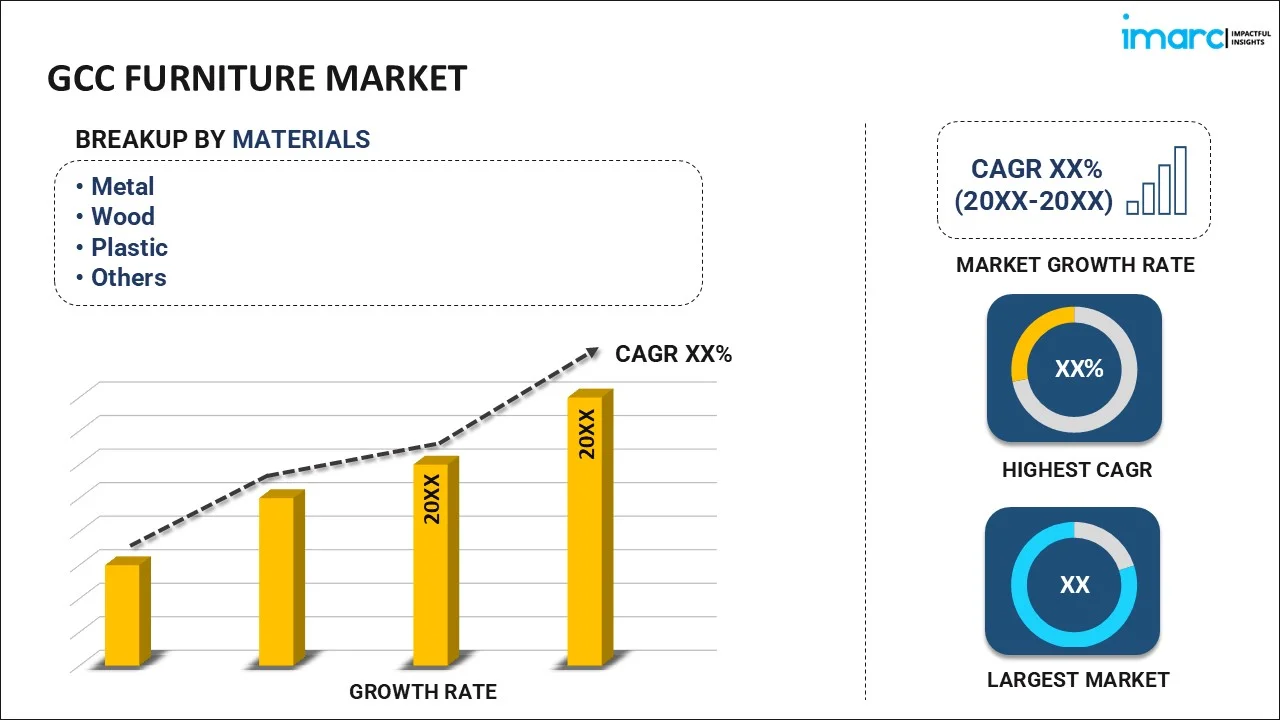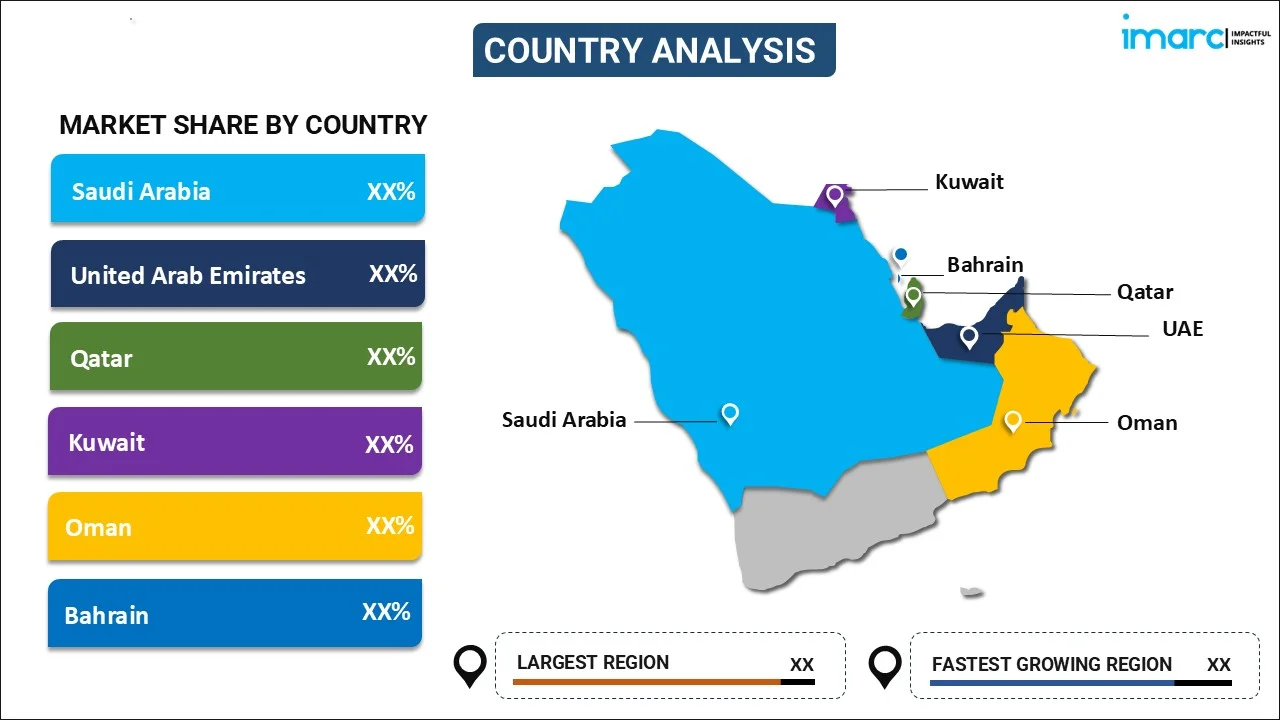
GCC Furniture Market Report by Material (Metal, Wood, Plastic, Glass, and Others), Distribution Channel (Supermarkets and Hypermarkets, Specialty Stores, Online Stores, and Others), End Use (Residential, Commercial), and Country 2025-2033
GCC Furniture Market Size:
The GCC furniture market size reached USD 15.3 Billion in 2024. Looking forward, IMARC Group expects the market to reach USD 28.3 Billion by 2033, exhibiting a growth rate (CAGR) of 7.2% during 2025-2033. The increasing demand for furniture due to rapid urbanization, rising disposable income, and increasing construction activities, the growing popularity of tourism, the expansion of the hospitality sector, and the widespread adoption of e-commerce and digitization represent some of the key factors driving the market. The market is experiencing steady growth driven by rapid urbanization and substantial infrastructure investments, rising trend of e-commerce and online furniture shopping, continual technological advancements, strategic partnerships and acquisitions among key players, and inflating disposable incomes of the individuals.
|
Report Attribute
|
Key Statistics
|
|---|---|
|
Base Year
|
2024 |
|
Forecast Years
|
2025-2033
|
|
Historical Years
|
2019-2024
|
| Market Size in 2024 | USD 15.3 Billion |
| Market Forecast in 2033 | USD 28.3 Billion |
| Market Growth Rate (2025-2033) | 7.2% |
GCC Furniture Market Analysis:
- Major Market Drivers: Rapid urbanization and growing construction expenditure in GCC countries, along with the influx of investments by both government and private sectors into residential, commercial as well as hospitality projects is driving the furniture industry across the GCC region. Moreover, inflating disposable incomes are encouraging consumers to spend more on luxury furniture products due to a modern lifestyle shift, leading to market expansion.
- Key Market Trends: The rising trend of e-commerce and online furniture shopping is remodeling the market for more convenience and product variety offered to customers. In addition, the increasing demand for quality-based designer-proclaimed and branded furniture in sync with affluence to luxurious lifestyles and interior aesthetics across the region is another significant market trend.
- Geographical Trends: The market in the UAE, Saudi Arabia, and Qatar is continuously growing on account of fast-paced urban development and large-scale investments into tourism and hospitality. Moreover, these countries hold the major GCC furniture market share as they are accommodating major global events, such as the Expo 2020 and the FIFA World Cup in 2022 fueling the need for contemporary and classy furniture.
- Competitive Landscape: The GCC furniture market is competitive, featuring a mix of global and regional players competing against each other. International marques are also making inroads in the market, driven by the growing consumption of high-end furniture more open to utilizing various ranges to cover broad consumer possibilities.
- Challenges and Opportunities: Dependence on oil and tourism among some economies may fluctuate quite heavily in the MENA GCC, depending broadly on political factors, which might limit overall market growth. However, the escalating number of infrastructure projects underway, an active tourism industry, and greater use of online furniture stores are offering opportunities to the key players.
GCC Furniture Market Trends:
Rapid urbanization and infrastructure development
Rapid urbanization and large spending on infrastructure in the GCC nations are major factors that drive the furniture industry. Along with this, the growing public and private investments in residential, commercial, and hospitality sectors are accelerating the demand for an extensive range of furniture, including home furnishing sectors, offices, and hotels. Apart from this, the growth of cities and the creation of new urban areas demand contemporary and fashionable furniture, which also drives the market growth. According to the GCC furniture market forecast, demand for construction and infrastructure projects in the GCC fueling the furniture market such as Dubai's Expo 2020 and preparation for the FIFA World Cup 2022 hosted by Qatar. Moreover, this accelerates the need for more furniture and attracts international brands to establish regional offices in town.
Rising disposable income and changing lifestyle
In addition, strong economic growth and high per capita income are leading to a rise in disposable income levels in the GCC. It is increasing the purchasing power of consumers who can spend more money on lifestyle products and home improvement products such as furnishings. Therefore, this is significantly supporting the market. In addition, the rising contemporary, luxurious living is prompting consumers to buy high-end, designer, and branded furniture, which is also propelling the GCC furniture market growth. E-commerce and online furniture shopping also worked in this regard, providing consumers with numerous varieties at home. Driven by growing interior awareness and aesthetic preference, consumers are spending on luxury furniture to refurbish their living and working premises.
Tourism and hospitality sector growth
Increasing emphasis on the tourism and hospitality sector in the GCC markets is driving the growth of this industry, creating immense demand for furniture. With the UAE, Saudi Arabia, and Qatar fast becoming the hub markets for tourist influx, there is a shortage of hotels, resorts, and serviced apartments that need to be added or upgraded. This growth requires robust investment in furniture for international tourists who have different standards and expectations. Thus, this is propelling the uptake of furniture in this region. Apart from this, the global business hub in the GCC attracts a lot of business travelers, prompting hotels and corporate offices to seek good furnishings of modern, comfortable furniture.
GCC Furniture Market Trends:
IMARC Group provides an analysis of the key trends in each segment of the GCC furniture market report, along with forecasts at the regional and country levels for 2025-2033. Our report has categorized the market based on material, distribution channel, and end use.
Breakup by Material:

- Metal
- Wood
- Plastic
- Glass
- Others
The report has provided a detailed breakup and analysis of the market based on the material. This includes metal, wood, plastic, glass, and others.
Breakup by Distribution Channel:
- Supermarkets and Hypermarkets
- Specialty stores
- Online stores
- Others
A detailed breakup and analysis of the market based on the distribution channel has also been provided in the report. This includes supermarkets and hypermarkets, specialty stores, online stores, and others.
Breakup by End Use:
- Residential
- Commercial
A detailed breakup and analysis of the market based on the end use has also been provided in the report. This includes residential and commercial.
Breakup by Country:

- Saudi Arabia
- UAE
- Qatar
- Bahrain
- Kuwait
- Oman
The report has also provided a comprehensive analysis of all the major regional markets, which include Saudi Arabia, the UAE, Qatar, Oman, Kuwait, and Bahrain.
Leading players in the GCC furniture market are vigorously expanding their product portfolio and improving the distribution network to exploit lucrative avenues. Larger brands are inclining to innovation, incorporating either sustainable materials or smart technology into their products to attract eco-friendly and tech-savvy consumers. According to the GCC furniture market overview, organizations are also expanding their market acknowledgment through strategic partnerships, acquisitions, and deal techniques. Additionally, digital transformation is buzzing several firms to reinforce their online presence with e-commerce platforms so that they can expand their customer spectrum. As the competition to cater to individual tastes and needs in the market increases, customized and personalized services have become more important for companies. By taking these steps, leading market participants are making their offerings more attractive and guaranteeing that they continue to be as adaptable and responsive as ever to the dynamics of the market that keeps on changing.
Competitive Landscape:
- The report has also provided a comprehensive analysis of the competitive landscape in the market. Competitive analysis such as market structure, key player positioning, top winning strategies, competitive dashboard, and company evaluation quadrant has been covered in the report. Also, detailed profiles of all major companies have been provided.
GCC Furniture Market News:
- May 31, 2024: Sophia Home, a leading luxury furniture store in UAE announced presenting its luxury furniture with limited edition exclusive collections during the Index Dubai, scheduled from June 4th to 6th at DWTC. This exhibition represents the global meeting point for creativity and innovation in furniture exhibitions.
- January 26, 2023: Majid Al Futtaim and Lifestyle Division acquired the rights to Poltrona Frau products in the UAE, marking its first foray into the luxury interior category and also launching the iconic Italian brand into a new growth phase across the Middle East.
GCC Furniture Market Report Scope:
| Report Features | Details |
|---|---|
| Base Year of the Analysis | 2024 |
| Historical Period | 2019-2024 |
| Forecast Period | 2025-2033 |
| Units | Billion USD |
| Scope of the Report | Exploration of Historical Trends and Market Outlook, Industry Catalysts and Challenges, Segment-Wise Historical and Future Market Assessment:
|
| Materials Covered | Metal, Wood, Plastic, Glass, Others |
| Distribution Channels Covered | Supermarkets and Hypermarkets, Specialty Stores, Online Stores, Others |
| End Uses Covered | Residential, Commercial |
| Countries Covered | Saudi Arabia, UAE, Qatar, Oman, Kuwait, Bahrain |
| Customization Scope | 10% Free Customization |
| Post-Sale Analyst Support | 10-12 Weeks |
| Delivery Format | PDF and Excel through Email (We can also provide the editable version of the report in PPT/Word format on special request) |
Key Questions Answered in This Report:
- How has the GCC furniture market performed so far, and how will it perform in the coming years?
- What has been the impact of COVID-19 on the GCC furniture market?
- What is the breakup of the GCC furniture market on the basis of material?
- What is the breakup of the GCC furniture market on the basis of distribution channel?
- What is the breakup of the GCC furniture market on the basis of end use?
- What are the various stages in the value chain of the GCC furniture market?
- What are the key driving factors and challenges in the GCC furniture market?
- What is the structure of the GCC furniture market, and who are the key players?
- What is the degree of competition in the GCC furniture market?
Key Benefits for Stakeholders:
- IMARC’s industry report offers a comprehensive quantitative analysis of various market segments, historical and current market trends, market forecasts, and dynamics of the GCC furniture market from 2019-2033.
- The research report provides the latest information on the market drivers, challenges, and opportunities in the GCC furniture market.
- The study maps the leading, as well as the fastest-growing, markets. It further enables stakeholders to identify the key country-level markets within the region.
- Porter's five forces analysis assists stakeholders in assessing the impact of new entrants, competitive rivalry, supplier power, buyer power, and the threat of substitution. It helps stakeholders to analyze the level of competition within the GCC furniture industry and its attractiveness.
- The competitive landscape allows stakeholders to understand their competitive environment and provides an insight into the current positions of key players in the market.
Need more help?
- Speak to our experienced analysts for insights on the current market scenarios.
- Include additional segments and countries to customize the report as per your requirement.
- Gain an unparalleled competitive advantage in your domain by understanding how to utilize the report and positively impacting your operations and revenue.
- For further assistance, please connect with our analysts.
 Inquire Before Buying
Inquire Before Buying
 Speak to an Analyst
Speak to an Analyst
 Request Brochure
Request Brochure
 Request Customization
Request Customization




.webp)




.webp)












